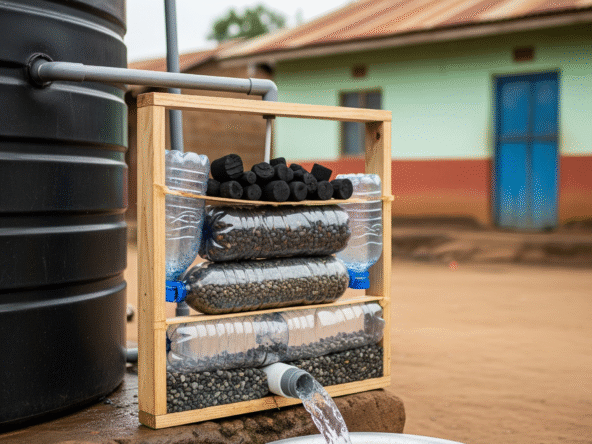Across Kenya especially in peri-urban and rural areas where grid electricity is often inconsistent and water supply irregular solar water pumping systems are fast becoming a game changer. By pairing solar-powered water pumps with water storage tanks, property owners can enjoy round-the-clock water access without recurring energy bills or fuel costs.
Whether you’re drawing water from a borehole, shallow well, or nearby stream, integrating a solar water pumping system into your compound infrastructure ensures efficiency, sustainability, and independence from public utilities. This guide breaks down how these systems work, what components you’ll need, and the best types of water tanks to complete your setup.
Why Choose Solar Water Pumping?
Opting for a solar-powered water pump makes sense in areas where grid power is either unreliable or unavailable altogether. With a solar setup, you eliminate electricity costs and fuel expenses often associated with petrol-powered water pumps. Once installed, the system uses free energy from the sun to draw water and store it in a tank for use any time day or night.
Solar pumps are particularly ideal for farms that require daytime irrigation, households with high daily water needs, and eco-conscious estates aiming to reduce their carbon footprint. When combined with a reliable storage solution like a poly tank, steel tank, or even concrete water tank, solar pumping becomes a complete water access system.
For reliable water storage options, refer to Top Water Tank Brands in Kenya, which lists quality manufacturers such as Roto, Kentank, Techno Tank, and Jojo.
Components of a Solar Water Pump System
A standard solar water pumping setup consists of four main components:
- Solar panels, which generate power from sunlight.
- A pump controller, which regulates the energy flowing to the pump.
- A water pump, either submersible (for boreholes) or surface-mounted (for shallow wells).
- A water storage tank to collect and hold the pumped water.
The tank’s size should correspond to your daily water consumption. For small-scale use, a 1,000 litre tank or 2,000 litre water tank is often sufficient. Larger properties with gardens, livestock, or multiple tenants will benefit from a 5,000 litre or 10,000 litre tank. Where space is limited, underground water tanks offer large capacity without taking up above-ground space.
To boost self-sufficiency, you can even combine solar pumping with Rainwater Harvesting in Kenya, capturing rain runoff from rooftops and storing it in the same system.
Choosing the Right Tank for Solar Pumping Systems
Selecting the right water storage tank to pair with your solar pump depends on your water source and usage. Here’s a general guide to matching tank sizes with household or property needs:
| Use Type | Recommended Tank Size |
|---|---|
| Small Household | 1,000L – 2,000L (e.g., 1000l tank) |
| Farm/Irrigation | 3,000L – 10,000L (5000l tank) |
| Estates or Multi-units | 10,000L+ (underground tanks) |
In space-constrained plots, rectangular water tanks offer efficient layout options, and for larger capacities, concrete or GRP tanks are ideal for long-term durability.
Installation Layout and Best Practices
For maximum efficiency, the solar pump should be installed as close to the water source as possible—whether that’s a borehole, river, or well. Place the solar panels in a spot with full-day sun exposure, ideally angled to capture the midday sun for optimal energy generation.
Your water tank should be installed on an elevated platform, such as a concrete or steel stand, to allow gravity-fed distribution. This reduces the need for additional pumping systems downstream.
If you’re optimizing your outdoor space for both utility and comfort, check out Outdoor Kitchens and Backyard Extensions for ideas on integrating tanks and storage into usable compound features.
Long-Term Maintenance and Efficiency Tips
Maintaining your solar pumping system is relatively low-cost, but regular care ensures optimal performance. Clean your solar panels frequently to remove dust or debris that might reduce output. Inspect the tank’s inlet and outlet valves to avoid clogging, and ensure any poly tank used outdoors is UV-treated for sun resistance.
If your system includes filters, they should be replaced annually or as recommended by the manufacturer. To further improve water efficiency, especially in homes, consider using Water-Saving Fixtures and Plumbing Tips, which reduce wastage and increase storage longevity.
Sample Budget for a Small Solar Pump + Tank System
A small but reliable solar water pump system suitable for farms or homes might include:
| Component | Estimated Cost (KSh) |
|---|---|
| 300W–500W Solar Panel | 15,000 – 30,000 |
| Pump Controller | 8,000 – 12,000 |
| Submersible Pump | 20,000 – 35,000 |
| 2,000L Water Tank | 15,000 – 20,000 |
| Tank Stand + Piping | 5,000 – 10,000 |
This setup provides enough capacity for household use, light irrigation, or small-scale livestock. You can easily scale this model up by increasing panel wattage, pump size, and tank capacity depending on your land size and daily water requirements.
Combining solar water pumps with high-quality water storage tanks is one of the smartest infrastructure decisions a Kenyan property owner can make. It supports water access independence, reduces utility costs, and aligns with sustainable energy goals. Whether you’re building in a rural village, planning a small farm, or developing a rental property, this system ensures reliable, affordable, and eco-friendly water delivery.
Continue Learning and Planning:


